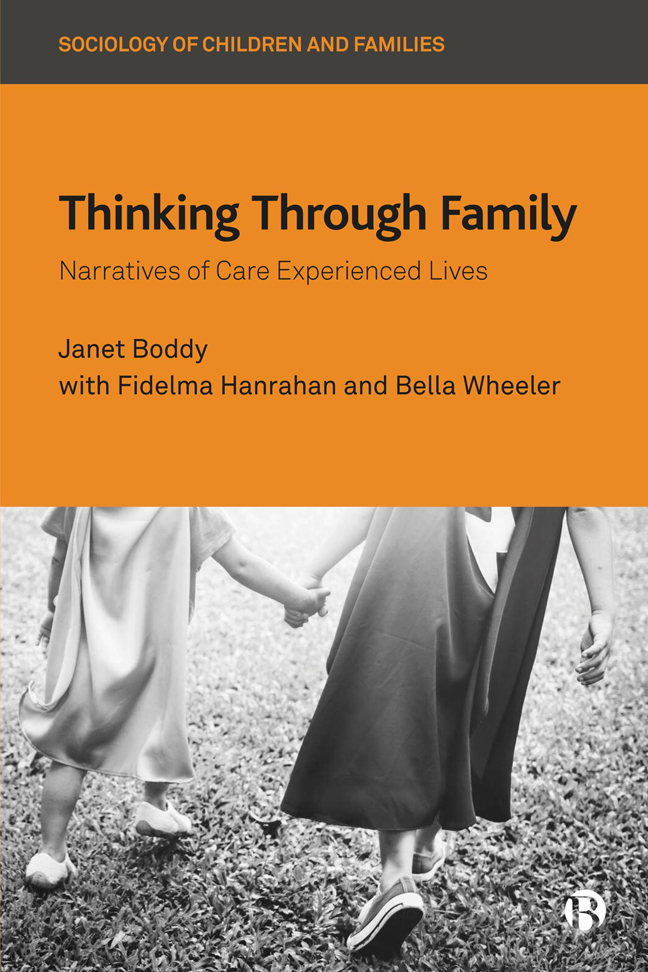Book contents
- Frontmatter
- Sensitive Content in this Book
- Dedication
- Miscellaneous Frontmatter
- Contents
- List of Figures and Table
- Acknowledgements
- 1 Why Think Through ‘Family’?
- 2 Learning From Care Experienced Perspectives
- 3 Doing Family: The Significance of the ‘Ordinary’
- 4 Re/Configuring Boundaries: Who Counts as ‘Family’?
- 5 ‘How Can We Not Talk about Family When Family's All That We’ve Got?’: Care and Connectedness
- 6 Understandings and Experiences of Parenthood
- 7 Thinking Through Family: Implications for Theory and Practice
- Notes
- References
- Index
4 - Re/Configuring Boundaries: Who Counts as ‘Family’?
Published online by Cambridge University Press: 24 January 2024
- Frontmatter
- Sensitive Content in this Book
- Dedication
- Miscellaneous Frontmatter
- Contents
- List of Figures and Table
- Acknowledgements
- 1 Why Think Through ‘Family’?
- 2 Learning From Care Experienced Perspectives
- 3 Doing Family: The Significance of the ‘Ordinary’
- 4 Re/Configuring Boundaries: Who Counts as ‘Family’?
- 5 ‘How Can We Not Talk about Family When Family's All That We’ve Got?’: Care and Connectedness
- 6 Understandings and Experiences of Parenthood
- 7 Thinking Through Family: Implications for Theory and Practice
- Notes
- References
- Index
Summary
‘Ordinary’ people are rather good at something that scientists who operate within a single paradigm are famously bad at: namely, traversing and experiencing everyday life connections between, for example, what we might think of as the genetic, the biological, the social, the cultural, the spiritual and so on, and understanding that there are no walls between these. People are routinely used to living such traversings in personal life … ‘the genetic’ is never just or only ‘the genetic’ – it is also always social, and always magical, and always ineffable for example, and these things segue and blur into and out of one another. People know that this is what life is.
Jennifer Mason, Affinities: Potent Connections in Personal Life, 2018, p 111Introduction
In the first chapters of this book, I argued for the need to recognize the dynamic contingencies and ambivalent complexities of ‘family’ for people with care experience. Continuing that discussion, this chapter considers how the boundaries of family are configured and reconfigured over space and time, drawing on narratives of kinship and family connection that span families of origin and experiences of placement in care. Thinking across these accounts, we see how meanings of ‘family’ may be simultaneously constant and fluid. Mason's (2018) account of affinities sets out the idea of ineffable kinship, which she defines as ‘a something that is in connection, with a charge that feels fixed, immutable and elemental’ (p 59). Some of the narratives detailed in this chapter resonate with that definition and show how understandings of family connections can endure despite conflict and complex disruptions. At the same time, as Mason writes in the epigraph to this chapter, the examples presented here show how understandings of kinship – of ‘who counts’ as family – may also ‘segue and blur in and out of one another’ (Mason, 2018, p 111), shifting over time.
Attention to the complexities of ‘who counts’ as family has both practical and theoretical value. Above all, a nuanced conceptualization of the diversity of family connectedness is necessary for policy and practice efforts to support people in navigating the complexities of their family relationships, both in and after care (see Holmes et al, 2020).
- Type
- Chapter
- Information
- Thinking through FamilyNarratives of Care Experienced Lives, pp. 70 - 94Publisher: Bristol University PressPrint publication year: 2023

